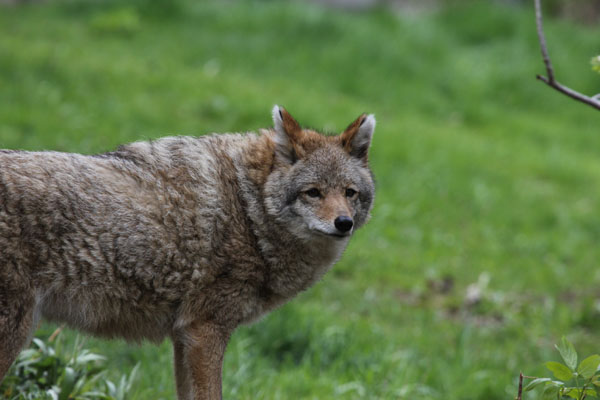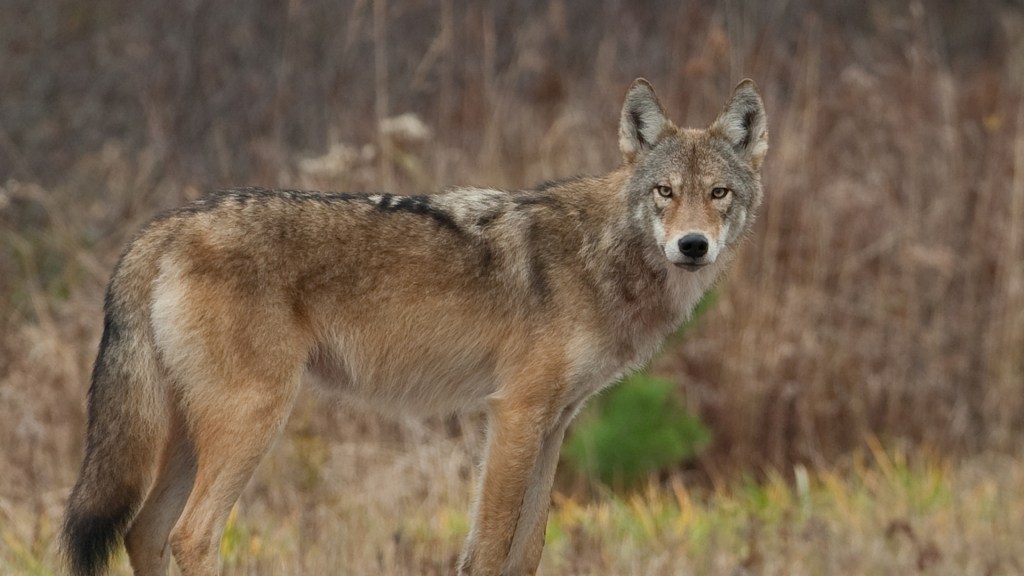In a Nutshell: Eastern wolves, often considered to be a hybrid of gray wolves and coyotes, actually represent a separate species, revealed by the latest genomic research published in Biology Letters. The paper also helps clarify the hybrid origins of other wild canines, including Eastern coyotes and Great Lakes wolves.
Unlike Little Red Riding Hood, most of us can tell the difference between a wolf and Grandmother. But beyond that: our wolf identification skills are probably not as good as we think.
Consider the names bandied about the popular media today: gray wolf, red wolf, coyote, coywolf, coydog. Which of these are species? What is the real deal with hybrids? What does it mean for conservation?
The answers are not simple, in large part because the topic of wolves and wolf hybrids often resides more in the realm of folklore than biology. A good way to pick a fight in any bar in rural America is to start offering opinions on “Canadian gray wolves” or “coywolves” or “eastern coyotes.”
What does the science say?
A new paper in the journal Biology Letters uses the latest genomic techniques to give a clearer picture of canid taxonomy and hybrid origins. The researchers used a technique called restriction site association DNA marker sequencing (RADSeq) and genomic simulations to resolve the hybrid status of wild canines in North America.
It’s only in the last ten years that these techniques have been developed to be able to understand complicated biological systems — not just in humans and fruit flies, but in wolves and all kinds of other creatures.
A whole new set of questions can now be answered with these genomic techniques – including questions about wolf hybrids.
Even the paper’s authors acknowledge that canine taxonomy can be, well…complicated.
“The genetics has gotten very complicated,” says the paper’s lead author, Linda Rutledge, post-doctoral researcher and instructor at Trent University, Ontario. “It’s very difficult for people to read genomic papers and understand them.”
So what should wildlife conservationists know about this research? Here are some key points.
Despite being often overlooked, Eastern wolves are a separate species.
The paper notes two prevailing evolutionary models for animals in the Canis genus in North America. One model maintains that there are two species of wild canids: the gray wolf (Canis lupus) and coyote (Canis latrans). Their comingling has also resulted in various hybrids.
The second adds a third species to the mix: the Eastern wolf (Canis lycaon).
For years, many have considered the Eastern wolf to be one of the hybrids of gray wolves and coyotes. This has led to confusion among policy makers and the general public.
The genomic research in this paper found no evidence that the Eastern wolf is a hybrid.
It’s a separate species.
Disagreement over the eastern wolf’s evolutionary history may be its biggest threat.
As geneticists debate, policy makers and wildlife managers base their decisions on confusing information. Or, more often: they feel paralyzed to make decisions.
Eastern wolves, though, need action. Their core population is centralized in Algonquin Provincial Park in Ontario. For many years, the animals could be legally shot as soon as they left the park.
That’s changed: there is now a buffer zone around the park that prohibits all hunting and trapping of wild canids.
But beyond that, protection of eastern wolves in Ontario is largely on paper only. Why? The eastern wolf is difficult to tell apart from the coyote. And coyotes can be hunted or trapped year round, without bag limits.
So it’s essentially open season on eastern wolves in potential expansion areas.
The paper’s authors hope that establishing the evolutionary history of the eastern wolf, demonstrating it is a species and not a hybrid, will lead to better protection.
“The eastern wolf needs a recovery plan that extends into dispersal areas, including Quebec,” says Rutledge. “There is wonderful habitat for them to disperse into; there just needs to be protection so they are not killed as soon as they disperse out of the buffer zone.”

Eastern coyotes and Great Lakes wolves are hybrids.
The genomic testing revealed three species of canids, but there are also hybrids arising from these species encountering each other.
Here is what the paper argues about hybrids.
Eastern coyotes are hybrids of western coyotes and eastern wolves. This is the animal often referred to as the coywolf.
Following extermination of wild canids in the eastern United States following European colonization, western coyotes began colonizing the habitat – and bred with eastern wolves when they encountered them on their expansion.
Great Lakes wolves are hybrids of gray wolves and eastern wolves.
Red wolves are likely the same species as eastern wolves.
The researchers did not test for red wolves for this paper, but relied on a body of work conducted previously.
These animals, once found in the southeastern United States, became critically endangered in the 1900s, and the last wild animals were gathered and placed in captive breeding facilities.
The captive breeding of a small population may have caused their genetics to diverge from eastern wolves. They have been since been reintroduced in sites of the Southeast – where they breed readily with coyotes, perhaps further confusing the genetic situation.
“The attention and controversy around wolves is all cultural, not biological,” says coauthor Paul Hohenlohe, assistant professor of biology at the University of Idaho. “But the reality is the biological situation is also complicated. It’s not static.”
The role of canids in ecosystems is as important as their evolutionary history.
Arguments about wolf management and conservation can quickly descend into trying to reconstruct the past. What wolf really belongs in the East? Were gray wolves there? Are Canadian gray wolves the same as Rocky Mountain wolves?
Historical records don’t help. European explorers were not taxonomists, let alone geneticists. They called things by confusing and inconsistent names: brush wolf and gray wolf and black wolf could all mean the same thing, or be perceived as different species.
And so obsessing over what canine belongs where can seem a futile quest.
Lead author Rutledge proposes another way for conservationists to approach this: focus on the ecosystem not the species.
“Conservation focuses on a very species-specific model,” she says. “Agencies often want to know first whether a species is taxonomically valid, but that may not be an efficient way to approach conservation in general. Our research shows that what species are can be very difficult to pin down.”
“But we know that ecosystems need top predators,” she continues. “That is so clear in the case of over-abundant white-tailed deer in eastern forests. The eastern wolf could play that role, if it could disperse.”
In other words: Let’s quit trying to make wolves fit into our neat little taxonomic boxes. Let’s focus instead on how to protect and restore their critical role as top predators.




So, you are saying that gray wolves and eastern wolves have hybridized? I did not know that. This article is eight years old I see and I’m arriving a little late, but still a fascinating interest of mine.
I learned the story of how the Algonquin (eastern) wolf was being exterminated early in the twentieth century and took to interbreeding with the coyotes which had reached Ontario by that time. Apparently a survival tactic employed by other species as well…
One of the last of the lobo wolves I know actually mated with a domestic collie and raised its pups.
So just this morning about two AM when I take my sheltie for a walk, the coywolves began their barking and howling right across the road from my house. I shouted two or three times to get them to shut up. It didn’t work so we continued with our walk.
I have a chicken breeding project, I’m the chicken aspie (aspergers) and I set up matings to prove the actual hybrid origin of the fowl, something that surprisingly has escaped the notice of poultry scientists. The human mind is a curious thing.
Anyway the coywolves have only attacked my birds only once in close to fourteen years. In turn I sometimes leave a deer carcass for them to scavange and they leave me alone though they roam all around the area. Beautiful animals if you’ve ever seen one…
I love hearing the coyotes sing. Neighbors raise livestock and any time a calf is killed, coyotes are blamed. The story is that they hunt in packs and attack fairly big prey, considering they are not so big themselves, and baby bison are sizable. A neighbor showed me one he had killed earlier that day. It was a beautiful beast, gorgeous coat, long bushy tail, bright white teeth and smaller than my german shepherd dog. I think they mourn their mates. I heard one calling one night. The song got more tentative and so sad it brought tears to my eyes. After one last call that sounded like a hopeless goodbye, all went silent.
I seem to having a problem’ I live in Manchester nj we have 3 that we know of coy wolfs 1 is over 100 lbs shorter ware with more red and black lt tan and white very strong and broad’ the other looks more like a coyote much smaller longer nose and ears only about 50 lb the other hides it’s black and has pointed ears med looks more like a Shepard ‘ the large one is not afraid to come close and Grauel saw it kill a dear ‘ the little one is very skittish but comes right out next to the dogs and has no problem with them ‘ not afraid of any noise ‘ black one always stays hidden close by’ so what’s going on here ? They haven’t left yet been over 6 weeks ‘ not feeding them !! They are the wild Turkey all the dear and cats around !
Interesting article. Talk about bar fights and wolves- I ran into an acquaintance on the trail who said he’d just seen two young, presumably wild, wolf like creatures. And I said, were they not coyotes? He said no, they were too big and strapping to be coyotes. So I said, probably the coy wolf then. And he said that he’d read that interbreeding between coyotes and wolves was biologically impossible. And I said, did you not See the PBS Nova special on the coy wolf??? :))
can a coydog be gray?